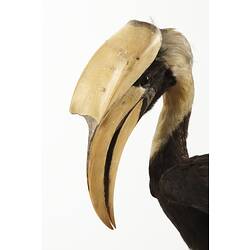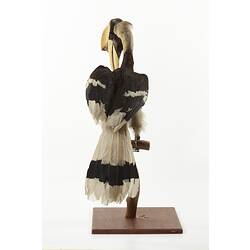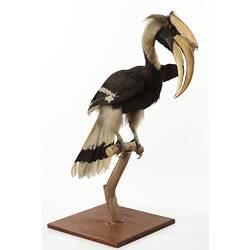Summary
The most obvious feature of the Great Hornbill is the dramatic structure above the beak. This yellow and black, u-shaped structure is known as a casque. All species of hornbill have a casque which is usually a hollow structure on the upper beak. They vary in size and appear to serve different functions in different species. The purpose of the casque in the Great Hornbill is not known but males sometimes butt each other midflight so it has possibly resulted from sexual selection. In some areas, Great Hornbills are hunted for their casque as well as for their feathers.
Great Hornbills have a wide but fragmented distribution. The largest populations occur in India around the Himalayan foothills, where this specimen came from. They are also found quite commonly in China, Bhutan, Thailand and Laos and less commonly in Nepal, Myanmar, Vietnam, Cambodia, Malaysia and Indonesia. Populations are declining in most counties, largely due to the reduction of suitable habitat, and in some it is now found only in protected areas.
The International Union for Conservation of Nature (IUCN) lists the Great Hornbill as being Near Threatened since they are susceptible to habitat deforestation due to logging and are at risk from over-hunting. They are also listed in Appendix I of the Convention on International Trade in Endangered Species (CITES) to ensure that international trade does not threaten them with extinction.
Specimen Details
-
Taxon Name
-
Preferred Common name
Great Hornbill
-
Specimen Nature
Nature: Mount, Form: Dry
-
Collected By
Unknown
-
Category
-
Scientific Group
-
Discipline
-
Collecting Areas
-
Type of Item
Taxonomy
-
Kingdom
-
Phylum
-
Subphylum
-
Class
-
Order
-
Family
-
Genus
-
Species Name
bicornis
Geospatial Information
-
Country
-
Precise Location
Himalayas






